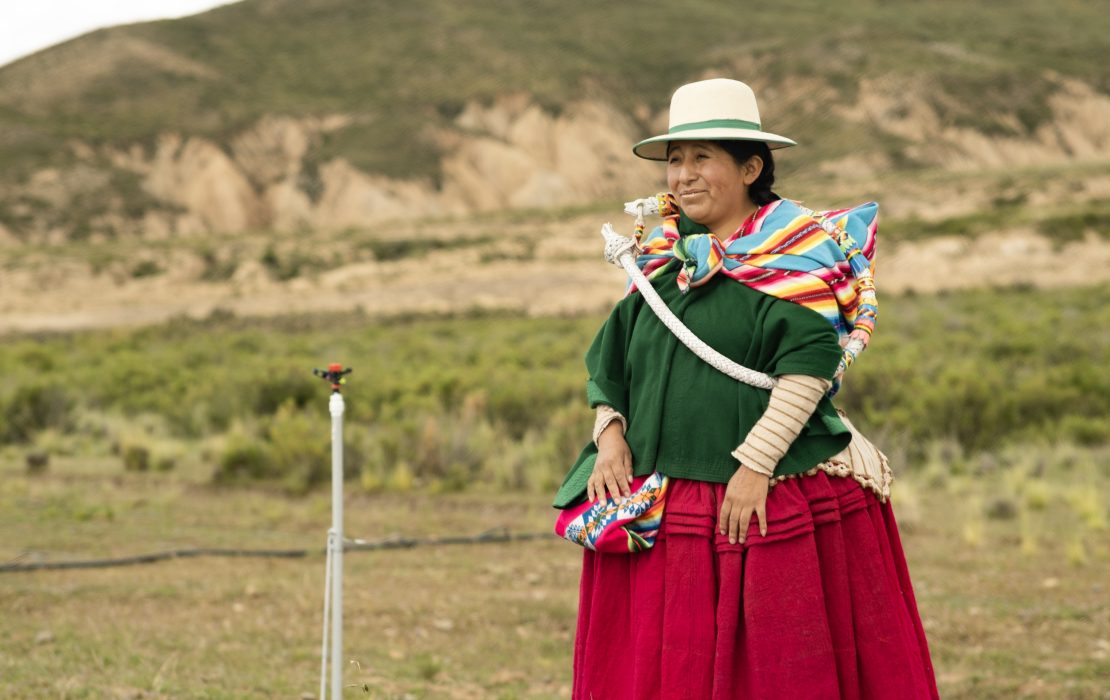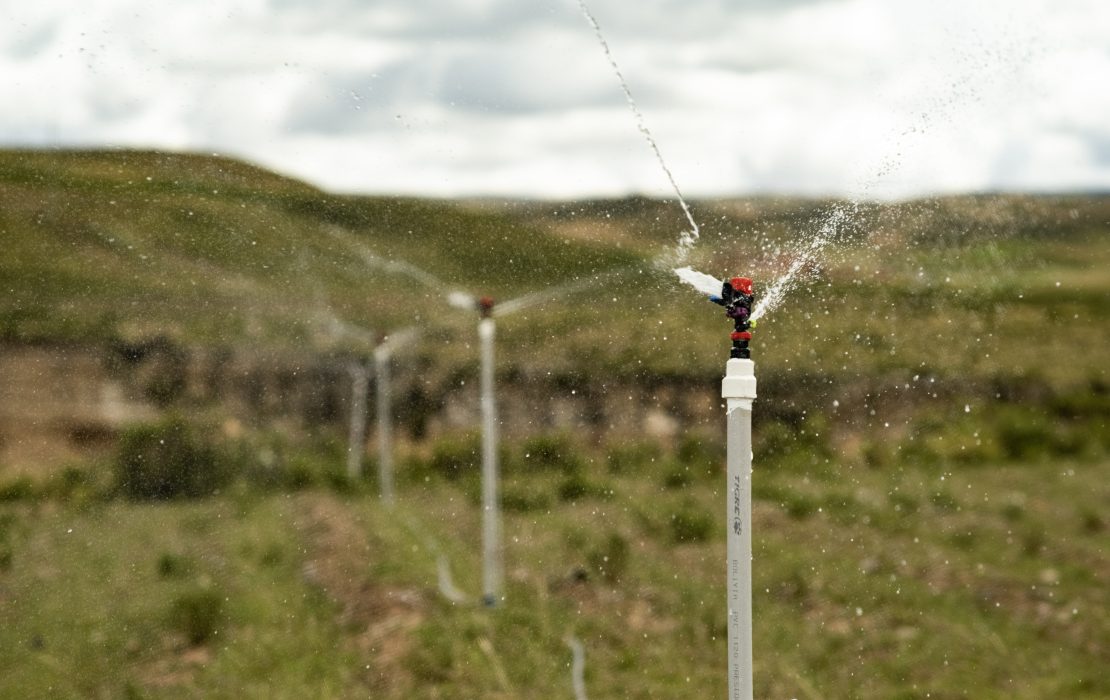
Photo: Practical Action Bolivia
In Bolivia, around one in three people live in rural areas, but this number is decreasing. As the impacts of climate change intensify, droughts and water scarcity are forcing communities that have traditionally relied on small scale agriculture to migrate to urban areas. With agricultural production reduced and food insecurity rising, many – especially young people and women – are looking for better opportunities in cities.
For those who remain in small rural villages, access to water depends on water pumps, most often powered by electricity. However, the national electricity grid only covers 81.5 percent of rural zones. For some small communities, coverage can be even lower, as is seen in the villages of Santiago de Callapa and Arani where electricity only reaches 53 percent and 56.6 percent of the village, respectively. Overall, around 200,000 households nationwide, the majority in rural and isolated areas, still don’t have access to electricity.
These rural communities usually resort to diesel or wood for powering their needs, including irrigating farms and domestic activities such as boiling water, heating or cooking. The use of these fossil fuels comes with its disadvantages: they can often be expensive, increase health risks and contribute to greenhouse gas emissions and deforestation.
But not everyone faces these challenges equally. Rural women face additional vulnerabilities to climate change impacts, water scarcity and lack of energy access, often being responsible for a much bigger share of the unpaid care burden in their households. They also have less access to resources, education and decision-making opportunities. Yet, their roles, experience and knowledge in managing resources like water and fuels are invaluable for their communities to adapt to the climate crisis.

Photo: Practical Action Bolivia

Photo: Practical Action Bolivia
“The impacts are larger on women, because it is women who have to feed their children,” says Verónica Villa. “We used to have llamas, piglets, chickens. Now we don’t, because it doesn’t rain, we have droughts, and the animals die or people sell them,” she explains.
Verónica is a young woman from Santiago de Callapa, a small village near La Paz, where 7,000 people live in the arid and cold landscape of the high planes, at an altitude of 3,800 meters above sea level. She is Secretary of the nation-wide organization, Bartolina Sisa Women Confederation, and part of a group of women who learned how to operate solar panels that were recently installed in their community to improve access to electricity and water. Since the installation of solar panels, farmers have seen yields of potato and barley crops increase significantly thanks to the availability of irrigated water resources.
"With this solar panel, everything is natural. With the sunlight, we can get water."

Verónica Villa is one of many women in rural communities in Bolivia who have learned how to operate and maintain solar energy systems to provide water to her community. Photo: Practical Action Bolivia

Photo: Practical Action Bolivia

Photo: Practical Action Bolivia
The solar panel was installed as part of an initiative supported by UNDP and implemented by Practical Action and the Government of Bolivia. This initiative brought clean energy solutions to three communities of less than 10,000 people: Santiago de Callapa, Arani and Yapacaní. Located in diverse geographies, from the high planes of the Andes to the lower lands in the east, these communities have their unique context and challenges. Assessing and understanding the sociocultural perceptions surrounding climate change and gender roles in these specific communities was key to gaining support from the municipality and local organizations, who helped implement the initiative. The project facilitated training sessions that built the capacity of 380 women around the use and maintenance of the technology and empowered them to participate in decision-making processes in the community.
“Women are waking up,” comments Verónica. “This project gave me hope to return here. We have rights and we have to continue.”
Overall, the initiative provided 14 organizations in the three communities with a hybrid technology that uses a combination of solar and conventional energy to pump water. Importantly, it also provided tools to strengthen efficiency in irrigation systems. This resulted in financial benefits for many farmers and their families due to reduced production costs. Moreover, as access to water increased due to the water pumps, new opportunities for livelihoods emerged, such as fish farming and cultivation of non-traditional crops.

Irrigation systems powered by solar energy help agricultural communities adapt in times of drought. Photo: Practical Action Bolivia
Photo: UNDP Bolivia/Carlos Arce Moreira
“When I was a kid, people produced potatoes, wheat, corn, peas. But with climate change, the rain decreased and the lands were abandoned. We are now reviving this. We are planting peach, custard apple, avocado,” says Miguel Angel Tosico, a member of the Agricultural Union Cuesta Pata, in Arani.
"The well has been here for a year. It used to work with a generator, but it was abandoned. We used to have to pay to use it, but not anymore."

Miguel Angel Tosico found new opportunities in the cultivation of peaches, custard apple and avocado helped by a water pump powered by solar panels. Photo: Practical Action Bolivia
To design this initiative, a series of dialogues with the communities helped ensure that the technology was tailored to local needs and practices, revitalizing ancestral knowledge related to energy, resource management and agriculture.
For example, in Yapacaní, the Asociación de Productoras Apícolas Las Meliponas (ASPROAM) previously harvested honey from the melipona bees manually, a time-consuming process that took women four hours to harvest one litre of honey. With the introduction of solar-powered pumps, they were able to extract one litre per hour, a 75 percent reduction in time, allowing this women's association to better manage and optimize honey production.
In Santiago de Callapa, the Productores en Cerámica y Artesanía (APCA), led mainly by women, adopted electricity-based technologies, such as electric ovens, lathes and spinning frames, to produce their ceramic and textile products and commodities. This means the artisans no longer rely on the use of fuelwood, which contributed to more efficient and sustainable production and reduced their impact on deforestation.

A women-led association adopted electricity-based technologies to produce their ceramic and textile products and commodities. Photo: Practical Action Bolivia

Photo: Practical Action Bolivia
The initiative has helped rural communities in Bolivia increase their resilience to climate change by adapting and diversifying their livelihoods, by integrating community perspectives into national policy, and by increasing the capacity of local organizations through training on climate change and the use of sustainable technologies.
In addition, it has provided important recommendations for Bolivia’s Long-Term Low Emission Development Strategy (LT-LEDS), currently under development, from the perspective of rural communities, ensuring that these types of initiatives can be scaled up in the future.
*
This initiative supports the Government of Bolivia’s efforts to promote gender equity and social inclusion in climate adaptation, mitigation, and financing, ensuring that gender sensitivity and inclusion considerations are integrated into the Long-Term Strategy. It was developed and implemented by Practical Action Bolivia in coordination with the Autoridad Plurinacional de la Madre Tierra with support from UNDP’s Climate Promise under the Pledge to Impact Programme.
Delivered in collaboration with a wide variety of partners, UNDP’s Climate Promise has supported over 120 countries to enhance and implement Nationally Determined Contributions (NDCs) under the Paris Agreement. Pledge to Impact is generously supported by the governments of Germany, Japan, United Kingdom, Sweden, Belgium, Spain, Iceland, the Netherlands, Portugal and other UNDP core contributors. This programme underpins UNDP’s contribution to the NDC Partnership.

